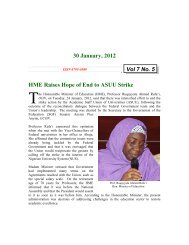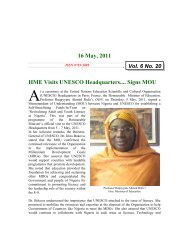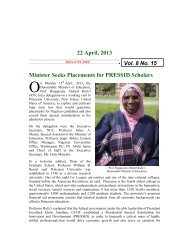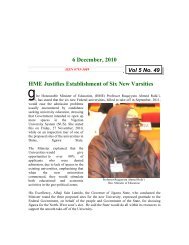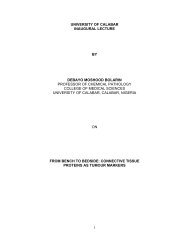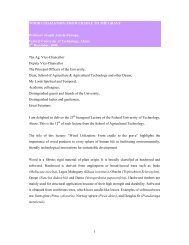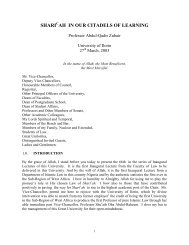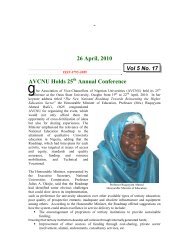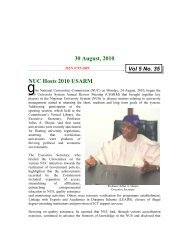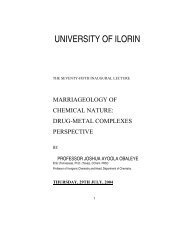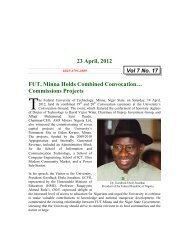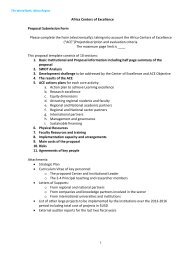Mechanization Of Cassava Production And Processing - National ...
Mechanization Of Cassava Production And Processing - National ...
Mechanization Of Cassava Production And Processing - National ...
Create successful ePaper yourself
Turn your PDF publications into a flip-book with our unique Google optimized e-Paper software.
MECHANIZATION OF CASSAVA PRODUCTION AND PROCESSING:<br />
A DECADE OF DESIGN AND DEVELOPMENT<br />
ABSTRACT<br />
AN INAUGURAL LECTURE<br />
By ENGR. (PROF.) E. U. ODIGBOH<br />
Agricultural Engineering Department<br />
Faculty of Engineering University of<br />
Nigeria, Nsukka.<br />
The inspiration behind agricultural mechanization may be summed up as follows: "If<br />
I dig with my hands the crust of the earth, my hands will blister and bleed. If between<br />
my hands and the soil I interpose a spade, then out of the labour of my body, the crust is<br />
broken and my hands remain whole". The mission of Agricultural Engineering is to<br />
mechanize agriculture. The agricultural engineer only seeks to extend the logic of the<br />
above quotation thus: "Let a machine be interposed between the man and the spade; the<br />
spade cuts, the machine labours, the field is tilled and the man is spared to turn his<br />
attention to other tasks, to higher levels of human endeavour". Surely, this is one of the<br />
most effective ways to "restore the dignity of man".<br />
In the face of soaring labour costs and the unfavourable position of agriculture as a<br />
competitor for labour among numerous dynamic and more lucrative sectors of the<br />
Nigerian economy and, faced with the ever increasing aversion of Nigerian youths to the<br />
drudgery, indegence and indignity of old-fashioned muscle-power subsistence agriculture,<br />
mechanization has become recognized as the missing input needed to accelerate agricultural<br />
production in Nigeria. Unfortunately, agricultural mechnization has not recorded<br />
much success in Nigeria. But much of the failures of agricultural mechanization in<br />
Nigeria, as in most of tropical Africa, can be traced to the near total dependence on<br />
agricultural machinery designed and manufactured by the industrialized countries for<br />
their own farmers and mostly temperate crops. These alien machinery and equipment<br />
are generally unsuitable to tropical pedoclimate and crops and are mostly so complex<br />
and costly that they are beyond the technical competence and financial reach of the<br />
farmers.<br />
Convinced that success of agricultural mechanization in Nigeria must depend on<br />
indigenous engineering initiative and effort, we devoted a good deal of time and resources<br />
to the design and development of machinery for our local crops, with special emphasis<br />
on machines for tropical root and tuber crops for which there are no machines available<br />
from our traditional overseas suppliers of agricultural machinery. In this lecture, we<br />
present brief descriptions of prototype machines which we developed in the past ten<br />
years specifically for the mechanization of cassava production and processing. The<br />
machines discussed include cassava planters, weeders, harvesters, peelers, graters,<br />
gari-mash pulverizer/sifter and gari frying machines. We hope that these machines can<br />
remove the drudgery from the onerous manual routines involved in the traditional<br />
cassava production and processing operations. We believe that if these machines are<br />
manufactured and made available, they will be significant constituents of the needed<br />
appropriate cassava mechanization technology for Nigeria and the other homologous<br />
producing countries of the world.<br />
Engr. (Prof.) E.U. Odigboh.
MECHANISATION OF CASSAVA PRODUCTION AND PROCESSING: A<br />
DECADE OF DESIGN AND REDEVELOPMENT<br />
AN INAUGURAL LECTURE<br />
By E. U.<br />
ODIGBOH<br />
Mr. Vice-Chancellor,<br />
Dean, Faculty of Engineering,<br />
Deans and Professors,<br />
Friends of the Faculty of Engineering,<br />
President, Nigerian Society of Engineers (Anambra Branch) - Engr. Egwuatu,<br />
Engr. Chief A.S. Umenyi,<br />
Commissioner for Agriculture - Engr. F. I. Idike,<br />
Chief G.E.Okeke,<br />
Director - The British Council, Enugu - Mr. P.P. Hilken,<br />
Distinguished Guests,<br />
Ladies and Genglemen,<br />
Welcome to my Inaugural<br />
Lecture. 1.<br />
INTRODUCTION<br />
It is my conception that research is a concrete expression of concern with<br />
the "ambient world" by an individual (or a group of individuals) desirous of<br />
progress or a change for the better. It is the organised systematic quest for new<br />
knowledge, based on the scientific method. The knowledge so gained may help<br />
only to satisfy uuinaii curiosity regarding the world around us. But generally, acquisition<br />
of new knowledge through research enchances man's capacity and ability to control and<br />
modify his environment, to more effectively utilize his natural resources to satisfy<br />
existential needs and thereby improve the welfare of his target groa of human beings.<br />
This lecture presents the highlights of my research efforts in the past ten years or sov<br />
aimed at engineering the mechanisation of cassava, production and processing, with<br />
Nigerian farmers as my target group of humans.<br />
Incidentally, this is the first inaugural lecture to be delivered by an agricultural<br />
engineer in University of Nigeria. I am proud that this is so because, I am the first<br />
Nigerian academic staff to be appointed in our Department of Agricultural Engineering,<br />
way back in 1966, nearly 20 years ago. It had been a challenging, albeit a rewarding<br />
experience. I recall still with some perplexity that I had the singular honour of ascending<br />
(o (he lofty position of Head of two departments in two separate faculties in 1970,<br />
i-ven with the substantive designation of assistant lecturer. That is a record and a piece of<br />
luslory which God forbid a repeat of the circumstances that made it possible. It was<br />
lough indeed. I only hope that, as a pioneer, I have established a tradition and an<br />
example worthy of emulation by my colleagues and younger agricultural engineers...But,
2. WHAT IS AGRICULTURAL ENGINEERING? WHO IS AN AGRICULTURAL<br />
ENGINEER? WHAT DOES HE DO?<br />
I was tempted to make these questions the title of this lecture because, these and similar<br />
questions are often asked even by people who ought to know. Therefore, Vice-Chancellor,<br />
Sir, permit me to use this opportunity to answer those questions as clearly as possible<br />
today. Any such questions, after today, should be treated as an exhibition of culpable<br />
ignorance on the part of the questioner!<br />
But seriously, I must acknowledge the fact that these questions are asked probably because,<br />
although the Agricultural Engineering Profession has a very bright future and a very active<br />
present, it has a very recent history worldwide. It first became a formalised discipline of<br />
engineering in USA when a group of engineers, trained as mechanical engineers, civil<br />
engineers, electrical engineers etc, but working in agriculture, got together to form the<br />
American Society of Agricultural Engineers in 1907. It came into existance as a natural<br />
evolutionary response to the dictates of division of labour and specialization, following the<br />
industrial revolution and the explosion of knowledge as a result of repaid growth and<br />
increasing sophistication of science and technology in American Agriculture. In Nigeria,<br />
there were no qualified agricultural engineers prior to 1960!<br />
It is well known that at the beginning, there was no differentiation in the engineering<br />
profession, except in terms of whether it was applied to miMtary or civil (i.e. non-military)<br />
purposes. Therefore, we had then just "Military Engineering" and "Civil Engineering". But<br />
as specialization became an economic and unaviodable necessity, different disciplines<br />
emerged. Out of the "Civil Engineering" of yore, todays civil, mechanical and electrical<br />
engineering disciplines were born. I believe that a similar story can be told about<br />
disciplines in the physical, biological, agricultural and social sciences as well as in the: arts<br />
and humanities. Ironically, the creation of many disciplines' within a given professional<br />
family tended to remove traditional boundaries between the disciplines, particularly as the<br />
disciplines grew and extended their spheres of endeavour. Therefore, again as a result of<br />
economic necessity and the demands of growing sophistication and complexity in the<br />
world of science and technology, there began a reverse process towards complementarity<br />
and synthesis.. The result is the birth of such newer disciplines as biochemistry,<br />
michrobiology, astrophysics, mathematical biology, etc in the biological arid physical<br />
sciences. Also in engineering, such newer disciplines as aeronautical engineering,<br />
bio-engineering, chemical engineering, communication engineering, mining engineering,<br />
agricultural engineering etc were born.<br />
Yet, agricultural engineering has certain unique features not necessarily present in the<br />
other disciplines. Simply defined, agricultural engineering is the application of<br />
engineering to agriculture. It deals with the economic utilization of any and all branches of<br />
engineering science and technology in the art, science and business of crop production and<br />
life-stock husbandry as well as in handling, processing and preservation, storage,<br />
manufacture and distribution of the products that feed, shelter and clothe mankind.<br />
Agricultural engineering is as extensive as agriculture and as diversified as engineering.
Indeed, agricultural engineering is a veritable analogue of the "Civil Engineering" of old.<br />
In addition to the training in the basic engineering sciences, the agricultural engineer<br />
usually specializes in one or two of the areas or options into which the agricultural<br />
engineering profession is technically classified namely:<br />
(i) FARM POWER AND MACHINERY<br />
(n) SOIL AND WATER ENGINEERING<br />
(iii) ELECTRIC POWER AND PROCESSING<br />
(iv) FARM STRUCTURES AND ENVIRONMENTAL CONTROL<br />
(v) FOOD ENGINEERING<br />
An agricultural engineer in the farm power and machinery option is a mechanical engineer<br />
that specializes in agricultural machinery and gadgets. An agricultural engineer<br />
specializing in soil and water engineering option has civil engineering training with<br />
emphasis on soil conservation and design and operation of irrigation and drainage works<br />
and systems. Planning of farm buildings layout, structural design of farm buildings and<br />
structures, and mechanization and control of the environment within the buildings are the<br />
responsibilities of the farm structures and environment expert. In agricultural products'<br />
processing and food engineering, the agricultural engineer is faced with the myraid and<br />
challenging problems of processing, preservation, handling and storage of agricultural<br />
produce. The agricultural engineer in this option has also to deal with food/ feed,<br />
beverage/drinks manufacture and presentation, to satisfy the ever growing demands of the<br />
sophisticated modern consumer. The processing and transformation of agricultural<br />
products into industrial raw materials form another important area of work.<br />
The areas of endeavour and expertise of agricultural engineers therefore, involve all phases<br />
of the agricultural industry and rural development. These include the evaluation,<br />
improvement, design and development, as well as the operation and maintenance of<br />
agricultural power units, machinery and equipment for primary production and processing<br />
of agricultural products as well as the transformation of the products into various foods,<br />
feeds fibres and industrial raw materials. Agricultural engineers also undertake advisory<br />
and consultancy work on systems of agricultural mechanisation and plant or machinery<br />
selection for agro-industrial enterprises.<br />
A very important concern of the agricultural engineer is the upliftment of the farmer and<br />
the rural family through the provision of such amenities as water, electricity, all-weather<br />
farm roads, farm/rural transportation, sewage and farmwaste disposal systems and<br />
agro-industrial cottage industries in the rural environment. The agricultural engineer is an<br />
engineer with an affection for the things of the farm, its rural environment, its people, its<br />
crops and animals, its soils and its vital place as a source of food and as the most important<br />
economic resource base for the nation. The fact that in the francophone countries,<br />
agricultural engineering is known as "genie rural" dramatises the point. The agricultural<br />
engineer is an engineer that adds a biological dimension to his engineering
training. He recognises the importance of the biological factor in the application of<br />
engineering technology to agriculture because he understands the principles of crop and<br />
lifestock management and production as well as the strengths and properties of plant and<br />
animal materials. The agricultural engineer is the principal agent for agricultural<br />
merchanization.<br />
What is agricultural engineering? Who is an agricultural engineer? What does he do?<br />
Vice-Chancellor, Sir, I believe I have briefly answered those questions. The inspiration<br />
behind agricultural mechanisation may be summed up simply as follows: "If I dig with my<br />
hand the crust of the earth, my hands will bleed. If between my hand and the soil I interpose<br />
a spade, then out of the labour of my body, the crust is broken and my hands remain<br />
whole". I have forgotten where I read that beautiful inspiring logic. But agricultural<br />
engineering and the agricultural engineer only seek to extend that simple logic thus, LET A<br />
MACHINE BE INTERPOSED BETWEEN THE MAN AND THE SPADE; THE SPADE<br />
CUTS, THE MACHINE LABOURS, THE FIELD IS TILLED AND THE MAN IS<br />
SPARED TO TURN HIS ATTENTION TO OTHER TASKS, TO HIGHER LEVELS OF<br />
HUMAN ENDEAVOUR (Odigboh, 1976). Surely, that is one of the most effective ways<br />
to "restore the dignity of man".<br />
3. NIGERIAN AGRICULTURAL MECHANIZATION RHETORICS<br />
In the face of soaring labour costs and the unfavourable position of agriculture as a<br />
competitor for labour among numerous dynamic and more lucrative sectors of the<br />
Nigerian economy and, faced with the ever increasing aversion of Nigerian youths to the<br />
drudgery, indigence and indignity of old-fashioned muscle-power subsistence agriculture<br />
as well as the worsening situation of hiking food prices, mechanization has become<br />
recognised as the missing input needed to accelerate Nigerian agricultural production<br />
(Odigboh 1979). But, inspite of all the noise and public offical declarations favouring<br />
agricultural mechanization, agriculture at the family farm level in Nigeria has remained the<br />
same as it was a century ago; if our ancestors from generations ago were to suddenly come<br />
back to life, they could pick up the same old and familiar tools and go to farm on equal<br />
terms with our present-day farmers because nothing has changed since their time. Perhaps,<br />
our ancestors' only surprise would be that mostly aged and ageing men and women are<br />
now left on the farms. So they would suffer no disadvantage whatsoever from the<br />
generation gap because our present-day "agricultural machinery" and implements still<br />
consist of the traditional hoe, the wooden digger, the matchet, the scythe, the sickle,<br />
wooden hooks and similar tools, all in their pristine shapes and sizes. In fact, our ancestors<br />
would quite justifiably have a certain feeling of superiority over our today's farmers<br />
because they could lay claim to the invention of the traditional tools currently in use. The<br />
farm power has also remained human muscle power. Those are the bare facts of the<br />
situation, as all of us know. The commentary on the situation by the "Daily Times"<br />
Columnist Aba Saheed gave the facts picturesquely in these words, "...As for our farmers,<br />
they should continue to till the ground and produce food for the masses. Their reward is in<br />
heaven! Meanwhile, my Government has decided to give every bona fide farmer a hoe, a<br />
cutlas, and a basket for harvest" (Saheed, 1979). Those are still the tacts which must not be<br />
confused by the existence, here and there, especially on government farms (nick-named<br />
"the civil servants' play grounds" by some cynics) of some imported tractors, modern farm<br />
machinery and even combines that seldom work (Odigboh 1980).
The very substantial economic growth that took place in Nigeria in the past decade has not<br />
benefited Nigerian farmers equitably. Perhaps Nigerian farmers may not justifiably stake a<br />
claim to a greater share of the country's economic well-being because, they themselves<br />
have failed to contribute significantly to the nation's economic growth. Whatever opinions<br />
others may hold on this, it is a fact that the average Nigerian farmer grows poorer in real<br />
and relative terms, year by year. As a class in the socio-economic<br />
structure, traditional Nigerian farmers have done as much to retard progress in Nigerian<br />
agriculture- as many of the commonly citied culprits. This the farmers have done by their<br />
passive example of abject poverty and subsistence existence which have compelled<br />
Nigerian youths to shun agriculture like the plague. In Nigeria, reference to farmers always<br />
conjures up the picture of the serf class of society, condemned to the indigence and<br />
indignity of a hand-to-mouth existence, literally scratching mother earth for a living. They<br />
seem to have been abandoned in a forgotten past while a small fraction of the Nigerian<br />
population marched off into the 20th century.<br />
In my view, the unfortunate sitution I have just described lias persisted and progressively<br />
worsened because, inspite of continuing official measures and substantial fund allocations<br />
to agriculture by a semmingly concerned Government, not enough is actually being done to<br />
provide effective technological inputs aimed at promoting the farmers' productive capacity<br />
and improving Nigerian rural life and income earning capacity. It is perhaps in recognition<br />
of this problem that the OAU Lagos Plan of Action stated as follows:<br />
"Agricultural mechanisation has a priority role in increasing agricultural production and in<br />
modernizing farms. However, this problem must be studied carefully and should be related<br />
to industrial development so that it will not further increase the dependency of African<br />
states on the industrialized countries of the world".<br />
Unfortunately, the problem has not been studied carefully in Nigeria. Our import-all<br />
approach to agricultural mechanisation continues to dangerously increase Nigeria's<br />
dependency on Europe, America and Ask.<br />
4. THE NEED FOR INDIGENOUS DESIGN AND DEVELOPMENT OF AGRICUL-<br />
TURAL MACHINERY<br />
The first ever UNIDO regional consultation meeting on agricultural machinery industry in<br />
Africa, co-sponsored by FAO- ECA, and OAU was held in Addis Ababa, Ethiopia from the<br />
5th to 9th April, 1982. The participants who came from countires of Europe, America, Asia<br />
as well as Africa condemmed in one voice the near total dependence of African agriculture<br />
on agricultural machinery designed and manufactured by the industrialized countries for<br />
their advanced farmers and mostly temperate crops. Much of the failure of agricultural<br />
mechanization was traced to this dependence on machinery and equipment which are<br />
generally unsuitable to African pedoclimate and crops and which are mostly so complex<br />
and costly that they are beyond the technical competence and financial reach of the<br />
farmers. The meeting unanimously adopted the recommendation that agricultural<br />
mechanisation in Africa should be based on machines designed and manufactured within<br />
the Region specifically for African farms and farmers.<br />
16<br />
It was the consensus that the agricultural njacninery industry could form the nucleus of<br />
African industrial development and should be a major component of the Industrial<br />
Development Decade for Africa. It was agreed that manufacture of agricultural machinery<br />
should be considered a viable first step for the establishment of the industrial infrastructure<br />
required for the manufacture of other capital goods (UNIDO 1982).<br />
I was contracted to write the Nigerian Country Paper for that UNIDO meeting (Odigboh<br />
1982). I personally participated in the consultation meeting and am in full<br />
agreement with the resolutions and recommendations. ".....If farmers everywhere could<br />
be blessed with the know-how, the freedom and the machines so typical of America, the<br />
hunger and famine which have stalked mankind since time began might well become a<br />
memory........" (Chicago Farm'Equipment Institute Journal). Yes indeed. But in recommending<br />
the American or European or Asian experience, the emphasis should be more
on their process of agricultural mechanization development rather than on wholesale and<br />
blind importation of machines and equipment often based on purely cosmetic<br />
considerations.<br />
The case for indigenous design and manufacture of agricultural machinery is easy to make<br />
for the following reasons:<br />
(i) The imported agricultural implements are generally unsuitable to the Nigerian climate<br />
and crops and are beyond the managerial ability and financial reach of the farmers.<br />
(ii) The imported agricultural machinery are designed to suit the farms and farming<br />
systems of their countries of origin without any considerations for those of Nigeria. Yet,<br />
these machines cost much more in Nigeria than in their countries of origin; so Nigerian<br />
farmers are compelled to pay more for inadequate equipment than their counterparts<br />
overseas.<br />
(iii) There are many staple food crops which are specific to Nigeria and for which there are<br />
no machinery of American, European or Asian origin (Odigboh,<br />
(iv) There are a number of unique Nigerian foods with unique processing techniques not<br />
known in those countries which we have adopted as suppliers foi all our agricultural<br />
mechanization hardwares (Odigboh, 1981).<br />
(v) Agricultural products vary so greatly with climatic conditions, cullmnl practices and<br />
crop varieties that techniques and equipment developed in our place cannot be applied<br />
successfully in another drastically different plan- d not modified to accommodate the<br />
differing human characteristics and cultural and technological conditions.<br />
(vi) The manufacturers in the industrialized countries of Europe ;md America )<br />
17
Therefore, it folows that to succeed, the mechanization of Nigerian Agriculture must be<br />
based largely on indigenous engineering research to design, develop and mass-produce<br />
locally most of the needed machines, equipment and gadgets, (Odigboh, 1978; 1980).<br />
ADVANTAGES OF LOCAL MANUFACTURE<br />
The reasons given to justify indigenous design and manufacture of agricultural machinery<br />
also provide clues to the advantages to be derived, as follows:<br />
(i) Agricultural machines, implements and gadgets specifically designed to meet the needs<br />
of Nigerian crops and farmers, and suitable for all phases of food production, can be<br />
manufactured. This will ensure that the ability of<br />
Nigeria to develop its agriculture will not be exclusively dependent on imported (and<br />
oftentimes inappropriate) equipment.<br />
(ii) Local agricultural machinery manufacture will facilitate the mass-production of those<br />
commonly used simple equipment which are no longer covered by patents and. similar<br />
restrictions, thereby achieving considerable savings in foreign exchange. But more<br />
importantly, local manufacture of the simple tools and processing equipment will have the<br />
psychological advantage of restoring our national self esteem.<br />
(iii) Local agro-equipment manufacture will encourage the development of a substantial<br />
amount of technological and industrial capability in Nigeria as it will encourage the<br />
development of ancillary industries. This will naturally help bring about rapid<br />
industrialization with the consequent creation of more job opportunities for graduates of<br />
technical colleges, for our technicians, craftsmen and artisans.<br />
(iv) The establishment of agricultural equipment manufacturing industry will generate a<br />
healthy competition between the indigenous industry and the foreign machinery<br />
manufacturing/marketing firms operating in the country. It will remove the monopoly of<br />
these foreign firms and ensure that they do not use Nigeria as a dumping ground for<br />
untested agricultural equipment.<br />
(v) Agricultural equipment manufacture will make it possible to help the neighbouring<br />
countries of Africa by providing their farmers with equipment suited to their crops and<br />
farmers.<br />
(vi) A viable machinery industry will encourage and stimulate engineering research to<br />
design and develop prototype machines to mechanize all phases of food production in<br />
Nigeria since all viable prototypes will have a chance of mass-product ion for distribution<br />
to the ultimate users, instead of being left to gather dust in our Universities and research<br />
institutes.<br />
18<br />
5. MACHINES FOR CASSAVA FIELD OPERATIONS<br />
Convinced a long time ago that success of agricultural mechanization in Nigeria must<br />
depend on indigenous engineering initiative and effort, we devoted a good deal of time and<br />
resources to the design and development of machinery for our local crops. In our design<br />
and development efforts, we gave special emphasis to machines for root and tuber crops for<br />
which there are no suitable machines available from our traditional overseas suppliers of<br />
agricultural machinery (Odigboh 1977). In this lecture, I have decided to present brief<br />
descriptions of prototype machines which we have developed specifically for the<br />
mechanization of cassava production and processing.<br />
A review of the literature shows that, in very sharp contrast to the global research thrust on<br />
all aspects of cassava agronomy, breeding, culture, diseases and pests etc, world attention<br />
to engineering design to mechanize cassava production field operations luis been very<br />
meagre and relatively insignificant in terms of concrete achievements or actu;il machines<br />
in the world market. Consequently, and although cassava remains indisputably a major<br />
food/cash crop of the tropical world, all the cultural operations for its production are still<br />
performed manually by the producers who are predominantly peasani farmers (Odigboh,<br />
1983). Literature documentation shows that cassava is one of tin-largest single crop of the<br />
tropics, particularly in South America and in those parts ol Africa .lying south of the Sahara
and north of the Zambezi where cassava has become the most important crop in terms of<br />
both the total land area devoted to its cultivation and as a major item of diet (Lockwood,<br />
1969;Nestel, 1973;Coursey, 1978; FAO, 1971). Nigeria is the largest producer of cassava<br />
in Africa with about 1.2 million ha under cultivation to supply <strong>Cassava</strong> almost exclusively<br />
for human food (FAO, 1968, 1977, <strong>Production</strong> Year Books). The need to mechanize<br />
cassava field operations has long been felt world-wide (Candenso, 1948; Kumar, 1962;<br />
Dimicali, 1964; Schulte, et al. l l )7t, Wahab et al. 1977: Makaniuola et al. 1973; Kemp,<br />
1978; etc). In Nigeria, with lire demand for cassava both for food and industrial uses now<br />
far in excess of supply, mechanization of cassava field operations has become imperative if<br />
the huge demand is to be met locally.<br />
5.1 THE CASSAVA PLANTER<br />
Planting is the first field operation for cassava production which requires a special<br />
equipment. For overall best agronomic results and maximum yield with bcsl loot bunch<br />
configuration for best harvesting ease, the experts recommend that cassava slake-, should<br />
be cut square into 20 - 25cm lengths, dip treated with fungicide and planted vertically on<br />
ridges to a depth of 10-15cm, at optimum plant densities of 1(),(MK) i 15625 plants/ha,<br />
in square or rectangular patterns.<br />
The variations in the physical properties of cassava cuttings and espei rally tlie presence of<br />
prominent nodes all over the surface, make the cassava stakes very mmiue planting<br />
materials which are extremely difficult to handle (Odigboh, 1976). Tins explain* why<br />
many attempts to mechanize cassava planting have not succeeded m i-mimf a commercial<br />
cassava planter on the world market. It also explains why many resean IKT. had favoured<br />
the transplanter principles or mechanism, but without much sm-
cuttings be fed individually, one by one, according to the diameter of the cuttings<br />
(Odigboh, 1978). It took until 1981, to develop what is considered to be the answer to the<br />
mechanization of cassava planting. The photograph of the single-row model of this ultimate<br />
design of an automatic cassava planter is shwon in Fig 3 with details of the design in Fig 4.<br />
The single-row model was designed as a module for the multi-row versions (Odigboh,<br />
1982). A iwo-row prototype completed in 1983 is shown in Fig 5. The prototype is<br />
integrally mounted to the tractor. The hopper design is very simple, as shown in Fig 6<br />
and yet very efficient. The planter performs very satisfactorily at planting speeds up to 8 km<br />
per hour, as shown in Fig 7. Yes, after so many years of tinkering, we are proud to say<br />
that here at last is an automatic cassava planter prototype that is ready for commercial<br />
manufacture. In fact, I was in Britain from March to June 1985, to build a commercial<br />
field prototype of the planter as shown in Fig 8.<br />
20<br />
/•is;. 2 Two-row automatic cassava planter model II (1977) (a)— Prototype planter<br />
trailed-in transport mode, (b)— Prototype planter in parked posi<br />
/•is;. 2 Two-row automatic cassava planter model II (1977) (a)— Prototype planter trailed-in<br />
transport mode, (b)— Prototype planter in parked position.
Fig. 3. Automatic cassava planter Model III,<br />
(a)— Single-row prototype built in 1981 (b)— Prototype mounted in transport mode<br />
22<br />
Sketch ol <strong>Cassava</strong> Planter Assembly (Side View)<br />
1. Hopper, 2. Metering drum, 3. Traction/Mechanism<br />
drive Wheel, 4. Wheel-depth adjuster, 5. Disc ridger,<br />
6. Furrower, 7. Delivery chute, 8. Three-point hitch,<br />
9. Load relief roof, 10. Cutting fall breaker/guide, 11.<br />
Rubber shield, 12. Hitch float pin, 13. Metering drum<br />
shield, 14. <strong>Cassava</strong> cutting about to drop into delivery<br />
Front View (Section) of Planter Prototype illustrating<br />
progression of Fall of <strong>Cassava</strong> Stake (S) into<br />
Furrower<br />
1. Hopper. 2. Metering drum, 3. Foam roller, 4. Fall<br />
breaker/ guide, 5. Delivery Chute, 6. Disc ridger. 7.<br />
Furrower, 8. Drive wheel, 9. Auxiliary hopper.<br />
(b) — Front view
Details of <strong>Cassava</strong> Cuttings Metering Assembly in<br />
Picking/Dropping Mode<br />
1. hopper, 2. metering drum, 3. lever, 4.<br />
cam, 5. foam in set in receptacle for cutting, 6.<br />
receptacle opening/closing flap, 7. delivery<br />
chute, 8. fulcrum, 9. load-relief roof, 10.<br />
stake fall beaker/ guid, 11. rubber shield,<br />
12. cassava stake, 13. leather - cover foam<br />
roller, 14. springy plate, r direction of<br />
rotation<br />
<strong>Cassava</strong> Cuttings Metering Assembly showing<br />
Receptacle Opening/Closing Flap in Closed<br />
Position
Fig. 8. Commercial prototype of Model HI <strong>Cassava</strong> planter built in 1985<br />
Britisli<br />
(The production of this commercial prototype cassava planter was wholly funded by tin<br />
Council I did the work at and with the help of Silsoe College, Faculty of Agricultural Engimvnng ,,l<br />
the Cranfield Institute of Technology, England. The assistance of the British Council »nd .'<br />
College is hereby gratefully acknowledged -------<br />
5.2 MECHANICAL WEEDER FOR THE CASSAVA CROP<br />
Timely weed control is a basic cultural requirement of the modern cassava prodw tion<br />
technology. Manual weed control is inefficient and constitutes a major cost factor i cassava<br />
production by peasant farmers. Many researchers (CIAT, 1979 & 1980; Onochk 1978,<br />
Akobundu, 1976; Harper, 1974) have recommended various weed control measure<br />
including both chemical and cultural approaches. But chemical weed control pose<br />
problems of high cost and oftentimes unavailability of appropriate herbicides and herb<br />
cide applicators. A more serious disadvantage of chemical weed control may be th<br />
lack of know-how with respect to the correct and safe handling of herbicides on th part<br />
of cassava farmers. Therefore, simple inexpensive mechanical weeders are wha the<br />
farmers need and we have developed two such weeders (Odigboh and Ahmed, 1980; one
manual and one motorised.<br />
The prototype called a ridge profile weeder, consists of two gangs of rotary hoe<br />
which are made to rest on the surface of two ridges facing a common furrow, as illuslni ted<br />
in Fig 9. In the manual version, the rotary hoes are ground driven as it is puslici along,<br />
while in the motorized version the rotary hoes are powered by a small intern; combustion<br />
engine. In both versions, the operator walks in the furrow and sinipl pushes the weeder<br />
along to weed one side each of two ridges. Thus the weeder cai handle the cassava crop,<br />
or indeed, any crop, planted on ridges, irrespective of the hei|/li of the plants. The shares on<br />
the gangs of the rotary hoe weeder are independent! adjustable to facilitate reaching the<br />
surfaces of the ridges. Field tests show thai Hi prototype weeders are very effective in<br />
controlling young weeds where light earl Inn up is required, in accordance with<br />
recommendations regarding the timing of week coni i< in a cassava crop (Onochie, 1975).<br />
This is another appropriate machine awaiting coinmci cialization.<br />
5.3 THE CASSAVA HARVESTER<br />
Echeveria (1975) reported a manual cassava harvesting rate of 215 man-h/lm<br />
Nigeria, we recorded an average manual cassava harvesting rate of about 0.1)1 ha/1<br />
Therefore, harvesting constitutes a major cost factor in cassava production, esprn.iM<br />
nowadays when agricultural labour is scarce and very expensive. With the emcr>',omr <<br />
commercial processing and ultilization of cassava, mechanized harvesting of cassava h.<br />
become an urgent necessity which has engaged the attention of many researchers vi the<br />
years (Essais, 1954; Krochmal, 1966; Echeveria, 1971; Kemp, 1978; Dia/ - Dmai 1979).<br />
Taking into consideration the unique characteristics of the cassava crop a !l r<<br />
harvesting (Odigboh, 1976), the prototype harvester shown in Fig. 10 was clevel|>
: ig. 9. Ridge-profile weeders<br />
(a) Manual prototype (19 79)<br />
(b) Motorized prototype (1980)
Pig. 10. Single-row reciprocating-hoe cassava harvester built in 1979<br />
(a) — Prototype harvester with front-mounted stem cutter/<br />
windrower and rear-mounted root lifter<br />
(b) — <strong>Cassava</strong> stem cutter/windrower prototype<br />
(c) — <strong>Cassava</strong> root lifter prototype<br />
— (d) - Close-up of reciprocating hoe of the root lift er
view of cassava root lifter prototype: 1 - reciprocating hoe, 2 - links suspending<br />
the hoe, 3 - main frame, 4 - rear wheels, 5 - drawbar on (6), 6 - special hitch<br />
attachment, 7 - systemof universal joints, 8 - universal joint from tractor<br />
P.T.O., 9 - gear-box, 10 - reciprocation pitman, 11 - gathering discs, 12 - gaurd<br />
frame work, 13 - weight box, 14 - tractor top link, 15 - tractor lower links, 16 -<br />
horizontal boom on (6), 17 — apron conveyor, 18 - collection box,' 19 - links<br />
supporting (17) from main frame, 20 — tractor rear wheels.<br />
Fig. We. Sketch of root lifter prototype showing some design details.<br />
The harvested tubers are dumped in heaps at intervals along the row for subsequent<br />
collection. Although a single-row harvester, field tests of the prototype gave a net harvesting<br />
rate of better than 0.35 ha/h at a speed of 4 km/h which is more than 40 men can<br />
achieve by hand. The percentages of broken, cut and skinned tubers vary somewhat with<br />
soil conditions but were less than possible in manual harvesting. This harvester concept is<br />
superior to other developments we have read about. As such, it represents another<br />
indigenously developed cassava production machine beggging to be manufactured and<br />
made available to the farmers.<br />
5.3.1 CASSAVA HARVESTING AIDS<br />
There is no doubt that the complete cassava harvester described above is very much<br />
needed for the timely supply of cassava tubers to the emerging factories in Nigeria, for<br />
the commercial production of flour, gari and other cassava products. Nevertheless,<br />
efforts have been made to develop cassava harvesting aids for use by the peasant farmers<br />
who are responsible for much of the cassava produced in all tropical countries of the<br />
world. Wijerwarden (1978) working at IITA in Ibadan, Nigeria reported the development of<br />
a fork lifter for uprooting cassava roots. We have made some modifications on the IITA<br />
lifter to yield the two cassava harvesting aids shown in Fig 11. Those harvesting aids<br />
have been found very effective under light or soft soil conditions. While they do not claim<br />
substantially increased harvesting rates, the harvesting aids certainly reduce the toilage<br />
and stoop labour inherent in manual harvesting with traditional tools.
Fig. 11. <strong>Cassava</strong> harvesting aids (<strong>Cassava</strong> root lifters - two versions)<br />
6. MACHINES FOR CASSAVA PROCEEDING<br />
There are many unit operations to which cassava roots must be subjected to<br />
produce a given food or product as illustrated in Fig 12. All the unit operations indicated Fig.<br />
12 can be mechanised but they are largely performed manually at village level Apart from<br />
the high labour intensity and drugdery involved in manual processing the conditions during<br />
the processes are generally unsanitary, often unhygienic mid unwlmlr some. Consequently<br />
the products are of variable and uncertain quality. Therefore it is necessary that efforts<br />
should be made to develop appropriate equipment for t h e var i ou s unit operations to<br />
minimise the tedium, improve the sanitation of the process conditions and ensure<br />
wholesomeness by establishing simple techniques for quality control (Odigboh 1983).<br />
In terms of the number of consumers, gari is the most important or the common<br />
processed food from cassava in Nigeria and West and (Vniial Ahir.i In most parts of<br />
West Africa, gari forms the main meal which the majority of the people, rich or poor, like<br />
to eat at least once a day. Some equipment for large-scale <strong>Processing</strong> of garri are now coming<br />
into use, as examplified by the Fabrlco, Newell Dunford ;and PRODA
fig. 12. General sequence of unit operations for processing cassava roots into<br />
various products.<br />
processing plants. But, the machinery for small-to-medium scale processing of gari are<br />
not well developed, even though there is evidence to show that small-scale operations<br />
may have points of efficiency and certain advantages over the large-scale enterprises<br />
(Ngoddy, 1976, 1978). Furthermore, over 90% of all the gari produced/consumed -in the<br />
region is produced by the small-scale processors who cannot afford the large scale plants,<br />
financiallly or technically. A flowchart describing the processing of cassava into gari is<br />
given in Fig. 13. Our design and development efforts have aimed at providing what we<br />
consider desirable or appropriate equipment for smail-to-medium scale processing of gari,<br />
as presented below.
Fig. 13. Gari processing flowchart<br />
CASSAVA PEELING MACHINES<br />
Nearly every cassava food product processing starts with peeling of the tubers. is<br />
probably becuase, the concentration of HCN responsible for cassava toxicity has ghest<br />
concentration in the cassava peel. The peeling of cassava tubers constitutes a r bottleneck<br />
in cassava processing. It is a problem which the large cassava processing s now available<br />
have not been able to solve satisfactorily. Mechanisation of this unit ition is very difficult<br />
because cassava tubers very widely in size and shape; the leal and mechanical<br />
properties relevant to the peering operations vary significantly age of the tubers, the time<br />
of the year when harvested as well as the time elapsed harvesting. An effective mechanical<br />
cassava peeler must be capable of handling all variations. (Odigboh, 1976). We have<br />
developed two such cassava peeling machines.<br />
THE CONTINUOUS-PROCESS CASSAVA PEELING MACHINE<br />
The first cassava peeler, developed in 1975, is a continuous proces^machine which ists of<br />
a cylinderical knife assembly (A) and a solid cylinder (B) mounted para^el 20 mm apart<br />
on an inclined frame as shown in Figure 14. The cassava tubers, cut 100 mm long pieces,<br />
are introduced length-wise through the feed channel (J). In »tlon A and B are rotated<br />
clockwise at 200 rpm and 88 rmp respectively. The va tuber pieces, lying between<br />
and pressed against the two cylinders, naturally e in an opposite direction and move<br />
down the inclination as the knives of A pro-ivcly peel them. There is a continuous flow<br />
of cassava tuber pieces which enter end of the machine unpeeled and come out of the<br />
other peeled, with a peeling<br />
iency of 95% at 135 kg/h when handling sized lots of cassava tuber pieces, jiw.i.<br />
io-7/a
6.1.2 THE BATCH PROCESS CASSAVA PEELING MACHINE<br />
To remove the need to cut the cassava tubers into short lengths and then size<br />
them before peeling, a batch-process abrasion peeling machine for whole tubers was<br />
designed in 1978. The prototype consists of a drum eccentrically mounted on a shaft as<br />
shown in Fig. 15. This was latter modified as shown in Fig. 16. To operate, the drum is<br />
loaded with a mixture of the cassava tubers and some inert abrasive materials. It is then<br />
rotated at an optimum speed of 40 rpm. As the drum rotates, water is sprayed onto the<br />
roots. The complex side-to-side and up-and-down motions of the drum, resulting from the<br />
eccentric mounting, lead to the complete peeling of the roots. Uniform and thorough<br />
peeling, better than possible manually, is achieved at about 180 kg/h irrespective of the<br />
sizes or shapes of the tubers. The peeled tubers from this prototype are shown in Fig. 17<br />
to illustrate that peeling is achieved with negligible loss of useful tuber flesh and that hand<br />
trimming is vertually eliminated (Odigboh 1979 & 1981).
These simple and very appropriate cassava peeling machines have been demonstrated<br />
at four national science and technology fairs since 1979, where they attracted<br />
considerable public and official commendations.<br />
6.2 CASSAVA GRATERS<br />
After peeling, the next unit operation in gari production is the grating of peeled<br />
cassava tubers. Manual grating as done traditionally is tedious aed time consuming and<br />
often involves scrapes and bloody injuries to the operators fingers. Thus, manual grating of<br />
cassava is unhygienic and leads to non-uniformity of the grated particles as well as<br />
substantial losses arising from the difficulty of holding small pieces of cassava tubers<br />
for grating.<br />
Fortunately there now exist various versions of mechanical gari graters powered<br />
by electric motors or small internal combustion engines. Our local artisans and craftsmen<br />
are able to fabricate the motorised mechanical graters which are found in common use<br />
along-side the now popular corn mill in village squares and markets.<br />
However, to cater for the interests of the preponderant majority of peasant gari<br />
producers who do not have electricity or the technical know-how to maintain internal<br />
combustion engines, we developed the manually operated gari grating machine shown in<br />
Fig. 18.<br />
The main attraction of this manual grating machine is its technical simplicity. It<br />
provides a powerful alternative to the sedentary drudgery and pain-inflicting process of<br />
the traditional manual cassava grating technique. The output of the prototype grater of<br />
125-185 kg/h is many times more than the 2 to 5 kg/h possible with the old traditional<br />
method. Loss or wastage of useful tuber flesh inherent in the traditional method is<br />
eliminated; a greatly improved quality product, in terms of the uniformity of particle
sizes of the resultant gari mash, is achieved and the product is infinitely more wholesome.<br />
Tliis manual gari grating machine is considered a very appropriate development that<br />
would meet the needs of thousands of peasant gari producers in most of West mid Central<br />
Africa if manufactured and made available to them (Odigboh, 1982).<br />
6.3 MACHINE FOR PULVERIZING/SIFTING GARI MASH<br />
In gari .processing, pulverization and sifting of the fermented cake of gari nush<br />
constitute the unit operations immediately preceeding garification. These two opeia<br />
tions are accomplished simultaneously in the traditional processing method by the<br />
women processors who do this by manually pressing and rubbing the mash cake ;I)MIM:>I<br />
sieves of wire mesh or rafia mat to remove the oversize particles and chaff. This l i a d i<br />
tional manual process is tedious, slow and understandably unhygienic. To save (h e<br />
small-to-medium scale gari processors and to improve the wholesomeness of the whole<br />
process, the prototype pulverizing/sifting machine shown in Fig. 19 was designed and<br />
built. The prototype machine accepts lumps of fermented and dewatered gari m.i-.h<br />
cuts them up into small pieces by a cake breaker and delivers the pieces by ;i bell<br />
conveyor on to a reciprocating sieve for sifting. The sifted gari mash and chaff sepauielv<br />
exist from the machine continuously. The prototype can handle 125 kg of in;ish |>ei<br />
hour to produce sifted gari mash which is more uniform and more wholesome ihan i\<br />
possible manually (Odigboh, 1982).
A Side view of the Prototype Gari mash Pulverizer/Sifting machine<br />
1. Vee-belt drives; 2. head pulley; 3. belt conveyor;4, cake Breaker; 5. tail pulley; 6.<br />
lump or cake of gari mash; 7, hopper; 8. pulverizing roller: 9. Side gaurds; 10.<br />
brush; 11. reciprocating sieve; 12. pitman.<br />
Fig. 19. Machine for pulverizing and sifting of dewatered gari-mash cake<br />
(a) — Two views of the prototype built in 1981<br />
(b)— Sketch showing some design details<br />
6.4 GARI FRYING MACHINE<br />
Garification is the term we use to describe the complex process of gari frying which is<br />
the terminal unit operation in gari production. Traditionally gari is fried by women in<br />
shallow earthen-ware or cast-iron pans (agbada) over a wood fire. The women use<br />
spatula-like paddles of wood or calabash sections to press the silted mash against the hot<br />
surfade of the frying pan, quickly scrape the mash off the hot surface to avoid burnmg,<br />
vigorously stir the mash and then repeat the series of operations. Unless this routine is<br />
correctly carried out, the resultant product will not have the unique properties of gari<br />
(Odigboh, 1983). As can be appreciated from this description of the process, manual<br />
frying of gari is leterally a hot business; the woman sits near the fire for the hour-long<br />
batch process, sweating profusely and pressing, scraping and stirring continuously to<br />
obtain an average of 3.5 kg of gari (Ibe, 1979). Naturally, the manual frying process is<br />
not quite hygienic as there is ample opportunity for contamination from sundry sources,<br />
including drops of sweat from the body of the operator. We therefore, feel justified in
providing a suitable alternative in the form of the prototype frying machine illustrated in<br />
Fig. 20 which was built in 1982 after two years of work.<br />
As described in greater detail elsewhere (Odigboh & Amed, 1982), the prototype<br />
gari frying machine is designed to faithfully stimulate the traditional manual frying<br />
technique described earlier. It has a semi-circular 1.7 m long frying trough of 57 nn<br />
diameter. The trough is mounted at an inclination variable from 0° to 20° to I<br />
lie-horizontal. Sixteen spring-loaded paddles are attached to a 1.75 cm long shaft<br />
mounted
Fig. 21 (a) End view of gari frying machine;<br />
axially in such a way as to locate the paddles inside and in comact with the trough as<br />
shown in Fig. 21. The paddles, spaced with small overlap, are angled relative to the axis<br />
of the trough to act* as a sort of conveyor. Driven by an electric motor through several<br />
speed redeucers and the linkage arrangements shown in Fig. 21, the gang of paddles<br />
oscillate through about 180° at 40 reversals per minute. As the paddles swing to and<br />
fro, sifted gari mash is automatically metered into the trough, once in a cycle of<br />
the to and from motion. Swinging to one direction, the paddles<br />
press the gari mash against the hot surface of the trough while in the opposite direction,<br />
they scrape the mash off, stir it and move it slightly forward to the exit of the trough.<br />
After appropriately adjusting the inclination of the trough, the quantity of mash metered<br />
and the heating rate, the frying machine operates automatically to produce a continuous<br />
flow of well fried gari at about 15% moisture content, we basis. At a specific setting of the<br />
machine to test the prototype, an average through-put of 66 kg of gari per hour was<br />
recorded. The prototype is also provided with an arrangement which makes it possible to<br />
operate the frying machine manually, as shown in Fig. 22. Intended to cater for the needs<br />
of the majority of the small gari processors, the manual version of the prototype gari<br />
frying machine effectively removes the tedium and drudgery of the traditional gari frying<br />
routine while producing a more wholesome product at a much faster rate bf 20 to 25 kg of<br />
gari per hour.<br />
This is yet another important development which should be produced to make it<br />
available to the intended users.<br />
Fig. 21 (b) Sketch illustrating the angle of oscillation of paddles and the mechanism of<br />
the metering device.<br />
H — hopper; Lj, L2 — metering lever in full-close and full-open positions of gate, G —<br />
resp; Pj, ?2 — gang of paddles at the end of scraping and pressing swings, resp; F —<br />
fulcrum for metering lever; Rj, R2 —direction of paddle swing for scraping and pressing,<br />
resp T — frying trough; S -shielding lip for trough; 9 — angle of paddle oscillation - 180°
6.5 OTHER CASSAVA PRODUCTS<br />
In this lecture, we have emphasized gari processing for obvious reasons. But,<br />
there are many other important food and non-food products of cassava that deserve at<br />
least a mention.<br />
<strong>Cassava</strong> starch is an important raw material in the manufacture of sand-paper, cardboard,<br />
charcola briquettes, dolls, flashlight batteries, molded plastic toys antihalation powders,<br />
photographic films, etc. (Vries,et al'. 1967). <strong>Cassava</strong> starch represents the best material for<br />
the manufacture of adhesives. It has a higher efficiency as a beater size in paper<br />
manufacture than other starches (Friedman, 1950). <strong>Cassava</strong> starch is preferred<br />
over others in laundry and textile industries. Its bland flavour, its non-retrogradation<br />
tendency and its excellent freezethaw stability make it the favourite of the food processors.<br />
These properties also recommend it as an excellent diluent in chemical and<br />
drug manufacture where it is used as a carrier in cosmetics, pills and capsules (Odigboh,<br />
1974). The use of cassava starch in drilling mud or in the manufacture of explosives<br />
and such other unsual applications may not be known to many, but its uses as a source<br />
for industrial sugars, acetone, alkoxides, alcohol, etc, are of common knowledge.<br />
Brazil, the country where cassava originated, is currently prosecuting a national<br />
programme to replace by 1990 all patroleum consumption with alcohol distilled principally<br />
from cassava. With the successful development of tliat technology, which is<br />
nearly assured akeady, the importance of cassava, particularly as a renewable energy<br />
resource, will reach a climax, and many poor tropical countries without mineral oil<br />
resources of their own will embrace the cassava plant as a new hope for their energy<br />
independence (Hammoud, 1977).<br />
However, cassava is most important internationally as a basic food and a hedge<br />
against hunger for the tropical millions of the world. Whereas gari, or its Brazilian<br />
analogue farinha, may be the most popular food product of cassava, there are hundreds of<br />
other cassava food forms. The tubers may be peeled, cut into pieces, dried and stored. The<br />
dried tubers are milled into a flour which is used in many different meal forms which go
under different names such as kokonte in Ghana, carima in Brazil, gaplek in Java and<br />
oke-akpu in Igboland of Nigeria. The meal form of cassava, made by a fermentation process<br />
is used to make a stiff paste called fufu in Sierra Leone and Ghana. This sort of meal is<br />
called Farinha d'agua in Brazil and apalapa in Igboland of Nigeria. When cassava starch is<br />
sifted and toasted while damp, the starch granules become gelatinized or partially<br />
dextrinized causing the starch particles to adhere, forming milky white balls known as<br />
pearl tapioca which is a commodity of commerce, used a great deal for puddings in USA and<br />
elsewhere. There are many delicious snack food forms of cassava such as yakayake in Ghana,<br />
agbeli kaklo in Sierra Leone, cassava pulav in India, cassava crab fritters in Colombia,<br />
abacha in Igboland of Nigeria, etc. Apart from the numerous traditional cassava foods,<br />
researchers are discovering other sophisticated food forms for cassava. Thus, cassava bread<br />
is now produced and accepted in many cassava producing countries. <strong>And</strong>, it may be<br />
possible soon for "cassava rice", cassava spagheti" and "cassava noodles" such as<br />
shown in Fig. 23 to find their way to supermarket shelves in the urban centres. To<br />
complete the picture, mention should also be made of the existence of beer and other<br />
drinks brewed from cassava. The food and feed uses of cassava really appear to be<br />
limitless but it is unfortunate that no standard or special-purpose machinery exists<br />
commercially for cassava processing. Producing countries of Asia, South America and<br />
Africa should do well to invest into the development and manufacture of the processing<br />
machinery themselves.<br />
7. CONCLUDING COMMENTS<br />
The weakness or near absence of mechanical-power mechanisation on Nigerian<br />
farms stems from a lot of fundamental problems which have not received adequate<br />
attention. <strong>Mechanization</strong> in Nigeria, as in most of Africa, has been said to be a victim of<br />
failures (UNIDO, 1983) for reasons very different from those given by opponents of<br />
mechanisation. The critical state of mechanization and its poor contribution to African<br />
agricultural development derive from its location at the interface of agriculture<br />
and the manufacturing industry, making mechanization a victin of both their problems<br />
and failures. It deserves repeating the emphasis that, to succeed, the mechanization of<br />
Nigerian agriculture must be based more on indigenous design, manufacture or adaptation<br />
of most of the needed machinery. Nigeria must regain control over the type of technology<br />
and mechanization used in its agriculture. To do otherwise and without this control,<br />
only one result is likely ...... the continuing failure of agriculture in Nigeria (Odigboh,<br />
1983).<br />
Vice-Chancellor, Sir, there exist many designs and prototype agricultural machines<br />
similar to those we have just described, which are left to gather dust in the various departments<br />
of agricultural engineering and some research institutes in Nigeria. We have<br />
publicized and demonstrated the prototype machines described here in many national<br />
fairs, we presented the developments in national and international seminars and<br />
symposia. All we get are verbal commendations and some certificates of merit. But,<br />
there is a crying need for the commercialization of all those indigenous designs and<br />
developments. If mass produced and made available to the farmers and the intended<br />
users, they will constitute the nucleus of the needed appropriate mechanization technology<br />
for Nigeria and the other homelogous tropical countries of West and Central Africa and<br />
indeed, the other producing countries in the world.<br />
In this respect, it is refreshing to recall the enthusiastic reaction and response which<br />
we got from the public, following recent news-media reports on our prototype machines, as<br />
exhibited during the 1985 Annual Conference of the Nigerian Society of Engineers at<br />
Enugu. The numerous letters and correspondences from individuals and companies,<br />
placing orders for the purchase or supply of those machines, indicate the level of<br />
potential demand .or peed for them. While definitely encouraging in themselves, those<br />
letters unfortunately demonstrate the apparent lack of understanding on the part of the<br />
public, of the inherent limitations of a researcher in a traditional University. They fail to<br />
appreciate the fact that as a Department, we are not equipped to manufacture our designs<br />
for sale to the intended users. This ought to be the responsibility of Nigerian entreprenuers<br />
and the manufacturing industry. It is indeed a fundamental problem, arising from the<br />
infant status of the manufacturing industry in Nigeria. Therefore, we take this<br />
opportunity to call for assistance from all quarters in both the public and private<br />
sectors, «to enable us set up a self-supporting shop, adequately staffed and equipped, to<br />
produce the machines even in limited numbers, pending the eventual takeover of the<br />
designs by entreprenuers for formal manufacture. We have done enough talking about<br />
agricultural mechanization in Nigeria; here is one opportunity to actually do something<br />
about it.<br />
Mr. Vice-Chancellor, Ladies and Gentlemen, I thank you most sincerely for your<br />
attention.
REFERENCES<br />
Akobundu, I C (1976). Weed control in root and tuber crops. Paper presented at 1st<br />
<strong>National</strong> <strong>Cassava</strong> Workshop. <strong>National</strong> Root Crop Research Institute,<br />
Umudike, Nigeria.<br />
Cardenso, B R (1948). A new planter for sugar cane, potatoes, cassava and similar crops.<br />
Agricultura Tropical (Columbia) 4:33 - 38.<br />
CIAT (1979, 1980) <strong>Cassava</strong> Annual Report. CIAT Series No. 02ECI - 78 and 02ECI<br />
-79. Centro International de Agricultura Tropical, Cali, Columbia.<br />
Coursey, D. G. (1978). <strong>Cassava</strong>: a major food crop of the Tropics. Paper presented at<br />
workshop on Cyanide Metabolism, sponsored by the European Molecular<br />
Biology Organisation, UK August 14-18.<br />
Diaz-Duran, A (1979). A <strong>Cassava</strong> Harvesting Aid. <strong>Cassava</strong> Information Centre publication,<br />
Series No. OSEEn - 3. CIAT, Cali. Columbia.<br />
Dimicali, A (1964). The sugar-cane cassava planter. Agricultural and Industrial v.//< 26(8):<br />
12.<br />
Echeverria, R.H. (1971). Feasibility Study for the Mechanical - Planting and Harvesting,<br />
of <strong>Cassava</strong> (in Spanish) Monograph, Maracy, University de Vcne/u;il.i<br />
Institutede Enginiera Agricole 15p.<br />
Essgis D E (1954). Trials with a cassava grip lifter (in French), Bulletin d'Infonndtixn de<br />
L'DNEAC 3(6): 343 - 345.<br />
Harper, R S (1974). Chemical weed control in cassava using paraquat. PANS 20: IKS<br />
189.<br />
Ibe, D G (1979). A partially mechanised village-scale gari production system. I'ux-ecd<br />
ing of Nigerian Society of Agricultural Engineers. Vol. 3 pp 223 - 22').<br />
Kemp, D. C. (1978). Harvesting: a field demonstration of two machines, in Ctutava<br />
Harvesting and <strong>Processing</strong> (Weber, E J, Cook, J H and Chouiuml A edl)<br />
Proceedings of workshop. IDRC - 114e.<br />
Krochmal, A (1966). Labour input and Mechanisation of cassava World (>/>v IS ( I)<br />
2 8 -30.<br />
Kumar, H (1962), Mechanisation of cassava planting Ghana Farmer 6 ( ' ), Hi.' KM<br />
Lockwood, R B (1969). Poisonous Food for millions. Pacific 7)i\< OIVM' 22 ( .'K U<br />
Makanjuola, G.A. Onochie, B.E. and Schulte, F. E (1973). PiHimin.nv .in.l ......<br />
mechanical harvesting of cassava roots in Nigeria. /',;;>
Odigboh, E U (1977). Problems and process in field mechanisation of Nigerian root and<br />
tuber crops. Proceedings of First <strong>National</strong> Seminar on Root aed Tuber<br />
Crops (Ene, LSO ed) NRCRI, Umudike (pp 113 - 120).<br />
Odigboh, E U (1978). A two-row automatic cassava cuttings planter: development,<br />
design and prototype construction. J of Agric Engineering Res 23:109-116.<br />
Odigboh, E U (1979). Mechanical devices for peeling cassava roots, in Small Scale <strong>Processing</strong><br />
and Storage of Tropical Root Crops (Pluncknett, D L ed) Westview Press.<br />
Boulder/Colorado.<br />
Odigboh, E U (1979). Agribusiness: the path to plenty. Proceedings of Nigerian Society<br />
of Agricultural Engineers: Vol 3. pp 16 - 22.<br />
Odigboh, E U (1980). Mechines for harvest and immediate post-harvest operations on<br />
Nigerian family farms. Paper presented on request as the International<br />
Conference on Mechanisation of Small-scale Farms in West and Central<br />
Africa. Younde, Cameroons June 2-10 sponsored by GTZ Germany.<br />
Odigboh, E U (1981). An abrasion cassava peeling machine Nigerian Journal of Engineering<br />
and Technology (NJET). 4 (Dec): 89 - 96.<br />
Odigboh, E U (1982). Agricultural Machinery Manufacturing Industry In Nigeria:<br />
Prospects and Problems. UNIDO Consultation Meeting, Addis Ababa,<br />
Ethiopia.<br />
Odighob, E U (1982). A Manually operated cassava grating machine. Submitted to<br />
Nigerian Journal of Technology (NIJOTECH).<br />
Odigboh, E U (1983). <strong>Cassava</strong>: <strong>Production</strong>, <strong>Processing</strong> and Utilization in Handbook of<br />
Tropical Foods. (Chan, H T ed). Marcel Dekker Inc N Y Chap 4 pp 145<br />
-200.<br />
Odigboh, E U (1983). Mechanisation of tillage in Nigeria: facts and fables. Paper<br />
presented at NSAE sponsored <strong>National</strong> Tillage Symposium. <strong>National</strong> Centre<br />
for Agricultural Mechanisation, florin, Nigeria (21 - 23) November).<br />
Odigboh, E U and Ahmed, S F (1980). Development of a ridge-profile weeder Nigerian<br />
Journal of Technology. (NIJOTECH) 4 (1): 1 - 7.<br />
Odigboh, E U and Ahmed, S F (1982). An automatic cassava planter. Agricultural<br />
Mechanisation in Asia, Africa and Latin America. 13 (3): 40 - 48.<br />
Odigboh, E U and Ahmed, S F (1982). A cassava harvester: design analysis and prototype<br />
development. Agricultural Mechanisation in Asia, Africa and Latin America. 13<br />
(3): 40-48.<br />
Odigboh, E U and Ahmed, S F (1982). A machine for pulverising and sifting gari mash.<br />
Submitted to Nigerian Journal of Techno logy (NIJOTECH).<br />
Odigboh, E U and Ahmed , S F (1982). Design of a continuous process gari frying machine.<br />
Proceeding of Nigerian Society of Agricultural Engineers Vol. (> pp. 65-75.<br />
Onochie, B E (1978). Weed control in root and tuber crops. In Proceeding* of<br />
tin-First <strong>National</strong> Seminar on Root and Tuber Crops (NRCRI), Umudike,<br />
Nigeri;i, pp. 12-23.<br />
Onochie, B E (1975). Critical periods for weed competition in cassava in Nigeria I'ANS<br />
21 (l):54-57.<br />
Sheed, A. (1977). "The Broadcast". Daily Times, August 10 p. 7<br />
Schulte, E E, Makanjuola, G A and Onochie, B F (1973). Mechanisation ol CUMVI<br />
production I: Planting. Paper presented at the third International Symposium<br />
on Tropical Root Crops. University of Ibadan, Nigeria.<br />
UNIDO (1982). First regional consultation meeting on the agricultural marlnm-i v<br />
industry. Addis Ababa Ethopia REPORT UNIDO Publication ID/.'Hs.<br />
ID/WG 365/8.
UNIDO (1983). Agricultural machinery and rural equipment in \l>i,.i A nrvv approach to a<br />
growing crisis. Sectorial Studies Series No 1. l.miiircl < lr,iiil> n<br />
tion,UNIDO/15.377.<br />
Wahab, A H, Robinson, R P and Hassan, I (1977). Mechanised planting of cassava stem<br />
cuttings on Gugana's light peat and peaty clays. Turrialba 27 (2): 137 - 141.<br />
Wijewarden,, R (1978). Notes on tools for productivity. <strong>National</strong> Committee on OFN<br />
sponsored seminar on <strong>Mechanization</strong> of Crop <strong>Production</strong>, Kaduna Nigeria.<br />
30,31 October.



